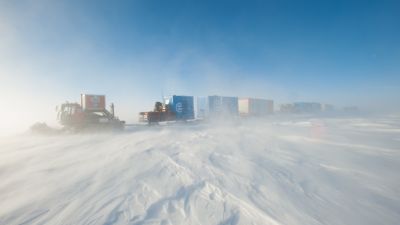
Supporting Science at the end of the world
I wanted to start the new year by updating you on what has been going on at Princess Elisabeth Antarctica during the last month. Let’s start with the science; As Antarctic Operators, our duty is to support scientists, guarantee their safety and ensure their work is carried out smoothly.
In the field with Glaciologists
As described in my previous post, we had to establish a new camp for Be:Wise project, close to the site of the former Roi Baudouin station. The new camp had to be installed not far from the Polarhav Ice Rise, which scientists want to study closely, because it plays a major role in limiting the speed of the ice shelf as it moves towards the sea. This place is full of Belgian history: Polarhav is the name of the one of the ships that brought the construction materials for the construction of the Roi Baudouin station in 1957.
We had to carry a lot of heavy GPS equipment to take continuous measurements for several years. To carry and install this gear, we decided to take a Prinoth tractor with us, in order to be more flexible. Immediately after having installed the camp, Raphy and myself went on a reconnaissance expedition to survey a dangerous crevasse zone on the Polarhev ice-rise. Since Reinhard Drews, the winner of the 2012 Inbev Baillet-Latour Fellowship, wants to install a GPS station there and take radar measurements throughout the whole area, we better make sure he does not fall into a crevasse in the process. The next day, we were really happy not to have postponed this essential task. We had very foggy weather and very poor visibility. But, with the bamboo sticks in place, marking the crevasses, and the safe route clearly marked, the scientists were able to do successfully carry out their mission.
Meanwhile, at Derwael Ice-Rise, the scientific team was very happy to have our mechanic Kristof with them. The ice-core drilling was progressing smoothly but, upon reaching a depth of 70 meters, they experienced some problems with the drill, as the ice was getting a lot harder. Kristof had a look at the drill, reshaped the clamps, tightened a few springs and replaced a few pieces and, presto, the drill was working again and the work could carry on.
After ten days in the field with Glaciologists, we headed back to the station to prepare our next big mission on the Antarctic plateau.
Heading towards the Antarctic Plateau
Antarctica is a treacherous and dangerous environment anywhere you go, but the Antarctic Plateau, 3000m above sea level is probably one of the most dangerous. Weather conditions there can be severe, as there is very little shelter from the cold Antarctic winds that can blow relentlessly. On top of that, both ice and crevasses move from year to year, so making a full reconnaissance is absolutely necessary.
Most of the Belgian scientific team was new to Antarctica. We gave them all a week of specific training before departure, to make sure they would be able to adapt to the harsh conditions they would inevitably meet on the plateau. They all did very well. Meanwhile, the Japanese team was loading its equipment aboard the two mobile units they asked the Belgian Polar Secretariat to repair for them last year.
A first convoy of three Prinoth tractors left the station on the 24th of December, carrying the heavy equipment necessary to install the field camp. It took us 16 hours to cross the 140km to the plateau, where we could finally drink a beer and eat a piece of Christmas cake! We then had to set up the camp while winds of 65 km/h were blowing, in temperatures as low as -22°C.
On the 26th, we welcomed the scientists who arrived on their skidoos, after an eight hours trip conducted by Jacques Richon, our doctor, who would stay with them for a week to make sure none of them had any problems with altitude and manage potential frostbite.
We arrived back at Princess Elisabeth Antarctica after a nine hour return trip and were all really happy to get some sleep.
Science is the "raison d'être" of the station and I firmly believe it is an important job to be carried out if we want to truly understand the world we live in and face the challenges that are upon us. For that reason, I am very proud of leading the team taking care of the logistics allowing that science to take place. If you want to discover what we do first hand, consider attending "Inside the Station", our interctive exhibition in Brussels.
Picture: Convoy on the Antarctic plateau - © International Polar Foundation
